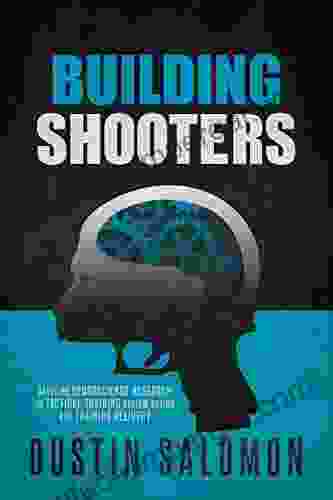Applying Neuroscience Research to Tactical Training System Design and Training

In today's demanding law enforcement and military environments, tactical training is paramount for ensuring the safety and effectiveness of personnel. Traditional training methods have often relied on trial-and-error approaches, but with the advent of neuroscience research, a new understanding of the human brain and learning has emerged. By integrating neuroscience principles into training system design and training programs, tactical teams can unlock peak performance and enhance mission readiness.
4.8 out of 5
| Language | : | English |
| File size | : | 7839 KB |
| Text-to-Speech | : | Enabled |
| Screen Reader | : | Supported |
| Enhanced typesetting | : | Enabled |
| Word Wise | : | Enabled |
| Print length | : | 154 pages |
| Lending | : | Enabled |
Neuroscience and Learning
Neuroscience research has shed light on the complex processes involved in learning and memory. The brain is a highly adaptable organ, capable of forming new neural connections and pathways in response to experiences. When tactical skills are repeatedly practiced under realistic conditions, the brain strengthens the neural circuits associated with those skills, making them faster and more automatic. This process, known as motor learning, is essential for developing proficiency in complex tactical maneuvers.
In addition to motor skills, neuroscience also highlights the importance of cognitive skills in tactical performance. Cognitive functions such as decision-making, problem-solving, and situational awareness rely on interconnected brain regions that process information from multiple sources. By training these cognitive skills through immersive simulations and cognitive exercises, tactical personnel can improve their ability to assess complex situations, make sound judgments, and respond appropriately under pressure.
Practical Applications in Training System Design
Understanding the neuroscience of learning has profound implications for tactical training system design. By incorporating principles of motor learning and cognitive enhancement into training programs, organizations can create more effective and engaging experiences for their personnel.
- Spaced Repetition: This technique involves distributing practice sessions over time, allowing for optimal consolidation of learning in the brain. By incorporating spaced repetition into training schedules, tactical teams can maximize retention and improve long-term recall.
- Varied Practice: Exposing trainees to diverse training scenarios and variations promotes adaptability and flexibility. The brain learns best when challenged with different contexts and conditions, so varying practice environments enhances the generalization of skills to real-world situations.
- Immersive Simulations: Virtual reality (VR) and augmented reality (AR) technologies offer immersive training environments that mimic real-life scenarios. These simulations provide a safe and controlled setting for trainees to practice complex skills, receive immediate feedback, and develop confidence.
- Cognitive Training Exercises: Exercises designed to enhance working memory, attention, and problem-solving abilities can improve cognitive performance in tactical situations. By integrating these exercises into training programs, tactical teams can strengthen their ability to make quick decisions and respond effectively to complex threats.
Benefits of Neuroscience-Informed Training
Adopting neuroscience-informed training approaches offers numerous benefits for tactical teams:
- Enhanced Proficiency: By targeting specific neural circuits and cognitive processes involved in tactical tasks, neuroscience-based training programs improve proficiency and reduce response times.
- Improved Decision-Making: Training that strengthens cognitive skills, such as decision-making and situational awareness, enables personnel to make sound judgments under pressure and respond appropriately to evolving threats.
- Reduced Training Time: By leveraging neuroscience principles to optimize training strategies, organizations can reduce the time required to achieve proficiency, allowing for greater cost-effectiveness and operational readiness.
- Increased Safety: Immersive simulations and cognitive exercises provide a safe and controlled environment for trainees to practice complex skills, reducing the risk of injuries or accidents.
- Tailored Training: Neuroscience-informed training can be customized to individual needs and learning styles, ensuring that each trainee receives the most effective instruction tailored to their specific requirements.
Incorporating neuroscience research into tactical training system design and training is a transformative approach that unlocks peak performance and enhances mission readiness. By understanding the principles of motor learning and cognitive enhancement, organizations can create more effective and engaging training experiences that strengthen neural circuits, develop cognitive skills, and improve decision-making. The benefits of neuroscience-informed training are far-reaching, resulting in enhanced proficiency, improved safety, reduced training time, and increased operational effectiveness. As neuroscience continues to evolve, the future of tactical training holds immense promise for revolutionizing the way personnel prepare for and execute their demanding roles.
Embracing the principles outlined in this article will empower tactical teams to achieve their full potential, ensuring the safety and success of their missions while safeguarding the communities they serve.
4.8 out of 5
| Language | : | English |
| File size | : | 7839 KB |
| Text-to-Speech | : | Enabled |
| Screen Reader | : | Supported |
| Enhanced typesetting | : | Enabled |
| Word Wise | : | Enabled |
| Print length | : | 154 pages |
| Lending | : | Enabled |
Do you want to contribute by writing guest posts on this blog?
Please contact us and send us a resume of previous articles that you have written.
 Book
Book Novel
Novel Page
Page Chapter
Chapter Text
Text Story
Story Genre
Genre Reader
Reader Library
Library Paperback
Paperback E-book
E-book Magazine
Magazine Newspaper
Newspaper Paragraph
Paragraph Sentence
Sentence Bookmark
Bookmark Shelf
Shelf Glossary
Glossary Bibliography
Bibliography Foreword
Foreword Preface
Preface Synopsis
Synopsis Annotation
Annotation Footnote
Footnote Manuscript
Manuscript Scroll
Scroll Codex
Codex Tome
Tome Bestseller
Bestseller Classics
Classics Library card
Library card Narrative
Narrative Biography
Biography Autobiography
Autobiography Memoir
Memoir Reference
Reference Encyclopedia
Encyclopedia Randal Root
Randal Root Eddie James
Eddie James Jane Burbank
Jane Burbank Robert Fathauer
Robert Fathauer Don N Hagist
Don N Hagist Paul Strikwerda
Paul Strikwerda S Ilan Troen
S Ilan Troen Dylane Moreau
Dylane Moreau Douglas Preston
Douglas Preston Lindsay C Gibson
Lindsay C Gibson Dylan Jones
Dylan Jones Nick Selby
Nick Selby Dodi Katrin Schmidt
Dodi Katrin Schmidt Kent Hartman
Kent Hartman Hayashi Fumiko
Hayashi Fumiko Larry Millett
Larry Millett Earl Shorris
Earl Shorris Tom Shales
Tom Shales Don Loucks
Don Loucks Dylan Schaffer
Dylan Schaffer
Light bulbAdvertise smarter! Our strategic ad space ensures maximum exposure. Reserve your spot today!
 Jared NelsonFollow ·14.5k
Jared NelsonFollow ·14.5k Rex HayesFollow ·10.3k
Rex HayesFollow ·10.3k Greg CoxFollow ·10k
Greg CoxFollow ·10k Donovan CarterFollow ·18.2k
Donovan CarterFollow ·18.2k Colt SimmonsFollow ·4.5k
Colt SimmonsFollow ·4.5k George OrwellFollow ·17k
George OrwellFollow ·17k Stephen KingFollow ·7.4k
Stephen KingFollow ·7.4k Mitch FosterFollow ·18.6k
Mitch FosterFollow ·18.6k

 Donovan Carter
Donovan CarterUnveiling the Tapestry of Western Civilization:...
: Step into the annals of Western...

 Pablo Neruda
Pablo NerudaUnveil the Secrets: The Welsh Murder Mysteries
Prepare to be captivated as...

 Benji Powell
Benji PowellNot Without Our Consent: Lakota Resistance to...
In the mid-20th...

 Ryan Foster
Ryan FosterUncover the Heroic Exploits of U.S. Navy Special Warfare...
The annals of modern warfare are replete...

 Gage Hayes
Gage HayesPlan to Provide Quality Care for All While Saving...
The healthcare...

 Felix Carter
Felix CarterUnveiling the Timeless Wisdom of Machiavelli: The...
Niccolò...
4.8 out of 5
| Language | : | English |
| File size | : | 7839 KB |
| Text-to-Speech | : | Enabled |
| Screen Reader | : | Supported |
| Enhanced typesetting | : | Enabled |
| Word Wise | : | Enabled |
| Print length | : | 154 pages |
| Lending | : | Enabled |












